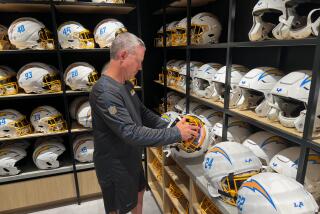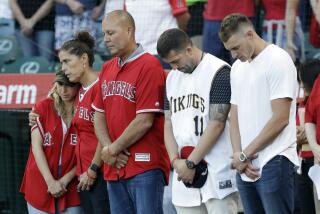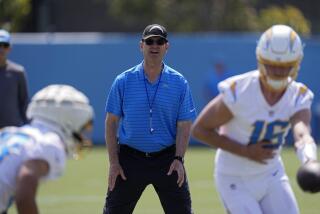NFL Gives Teams More Leeway for Spot Drug Testing
- Share via
SAN DIEGO — Team doctors have new authority to order random tests for suspected drug abusers under conditions spelled out in a recent memo from the National Football League Management Council.
Team physicians, acting on input from position coaches, trainers and strength coaches, now can direct a player to submit to a urinalysis based on a cumulative pattern of danger signals outlined in the memo, a copy of which was obtained by The Times.
An attorney for the NFL Players Assn. said the memo appears to ignore the league’s collective bargaining agreement by putting non-medical personnel in a position to make judgments on possible drug abuse.
“Coaches are not medical experts,” said Dick Berthelsen, counsel for the NFLPA. “We don’t want this matter in the hands of amateurs.”
Berthelsen said he feared drug-related information supplied by coaches might be used against a player in a dispute (over a contract or other issues).
Such fears are secondary to the overall problem of illegal drug use, according to team doctors who asked the management council to clarify the collective bargaining agreement’s position on random testing.
“This is a first step toward addressing the problem of drug abuse, which can only be resolved by random testing (of all players),” said Gary Losse, a team physician for the San Diego Chargers.
“I recognize that this is a sensitive matter, and I want to make it perfectly clear that a coach cannot come to me, or any team doctor, and order a urinalysis for a player. The coach can present his observations, and if in the judgment of the doctor a test is indicated, it can be ordered.”
Tom Bass, defensive coordinator for the Chargers, said he has been more than casually aware of possible drug symptoms among players for many years.
“This isn’t going to lead to a police state,” Bass said. “We’re not going to see coaches going crazy or getting paranoid if some guy misses five tackles.
“But I believe if a player deviates significantly from his normal pattern of behavior, you have an obligation to check it out.”
The matter grows more complex if a player refuses urinalysis. The doctor can’t enforce the test and can’t mandate what happens to the player, according to Losse.
“That’s an administrative problem, and the team physician is not an administrator,” Losse said.
“There will be a percentage of players, probably very small, who will object that this represents an invasion of privacy, but I believe that a greater percentage of drug abusers will now be identified. Team doctors are not going to be abusing this mandate.”
The collective bargaining agreement stipulates that a player may be tested for possible use “upon reasonable cause.”
The management council memo, dated July 24, is a response to the requests of coaches and trainers for pointers on patterns of behavior that constitute “reasonable cause.”
The memo from Sarge Karch, an attorney for the management council, specifies events in a player’s background that give a club a clear right to test:
--Prior treatment for drug abuse.
--A positive result for an illegal drug in a prior club physical exam.
--Involvement in the criminal-justice system that confirms use of illegal drugs.
--Prior disciplinary action by the commissioner for drug use.
There appears to be little or no grounds for challenging these conditions.
Charger linebacker Mike Green, arrested two weeks ago on drug charges, agreed to random testing, stipulated by owner Alex Spanos as a condition of remaining on the team.
The sensitive portion of the league memo relates to the newly specified second level of “reasonable cause.” Coaches and trainers--those with a close working knowledge of a player’s habits and abilities--have been given a lengthy list of danger signals that could point to drug involvement.
The memo spells out those danger signals under the headings “personality, physical condition and performance.”
Under personality, things to look for include frequent mood swings; unexplained extremes in emotion; well-documented unusual behavior at practices or meetings; impaired judgment, and going from hero to goat due to a game incident, with the player dwelling on the error for an unreasonable period of time.
The memo states that extremes of anger, sadness and guilt may result in loneliness and fear of detection concerning private life, which can signal the advent of dependency.
Under physical condition, the memo lists the following danger signs: rapid weight loss (free basing cocaine often leads to this result); fat accumulation on a normally trim body (drug use may cause a person to load up on junk food); loss of muscle mass and inability to do normal repetitions in weight training; loss of speed (best time to test this is after days off); loss of endurance, and lethargy.
Also, an unusual number of orthopedic problems; breathing and respiratory problems; chronic diarrhea; ill longer than usual; complaints of sore muscles.
Film documentation is valuable in evaluating the danger signals related to performance, which the memo specifies as: impaired concentration (missing signals, running wrong pass routes, etc.); avoidance of pain (stays down longer when hit; goes from primary to secondary tackler); and cutting of practice.
“Keep in mind,” the memo says, “that one isolated manifestation of a danger signal does not necessarily point to drug use. But several repetitions of any danger signal . . . or signals from two or more (categories) may point to the need for testing.”
The memo concludes by stressing that when reasonable cause for testing appears to be present, the team doctor must be consulted.
“This isn’t a grab for power by doctors,” Losse said. “It’s merely an elucidation of what was formerly an ambiguous part of the collective bargaining agreement.
“People assume drug abuse is purely a medical problem, and that only doctors can make the determination of whether a player is suspect. But, in fact, this problem often manifests itself in behavioral changes, which now are spelled out.
“Team physicians simply are not in the presence of the players to the extent that coaches and trainers are.”
The management council’s edict may pose a bit of a problem for the delicate relationship that exists between trainers and athletes.
Ric McDonald, the Chargers’ head trainer, said it’s not his job to get a player to undergo drug treatment or to confront a suspected drug abuser.
“We’re all aware of the problem that exists,” McDonald said, “and we certainly want to do all that we can to correct it. But it’s not the role of the trainer to be a drug counselor.
“Traditionally, the trainer has served as a buffer between the coaching staff and the players, and it’s important to maintain that relationship. I wouldn’t want to see players lose confidence in their relationship with their trainers.”
More to Read
Go beyond the scoreboard
Get the latest on L.A.'s teams in the daily Sports Report newsletter.
You may occasionally receive promotional content from the Los Angeles Times.










